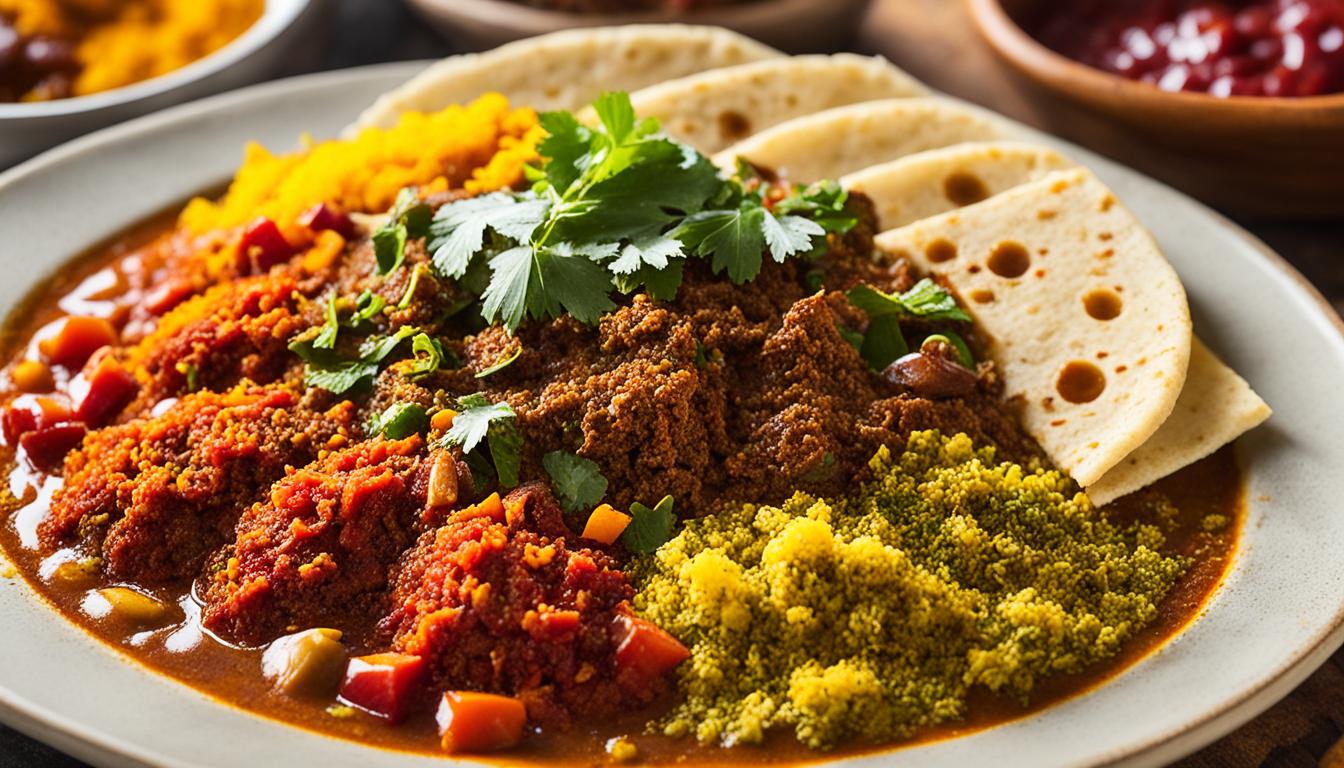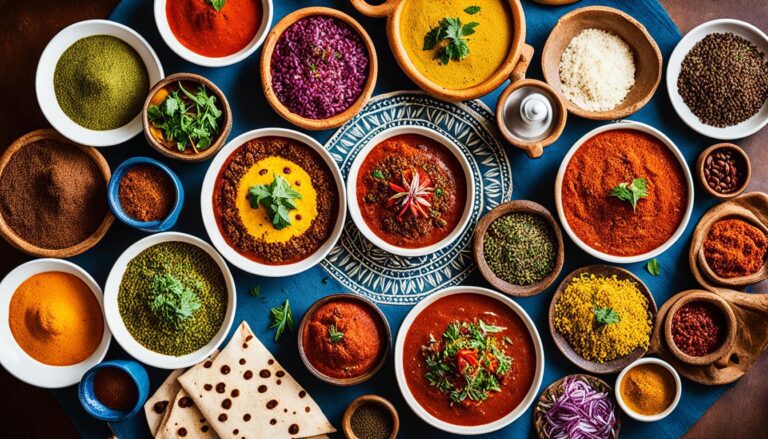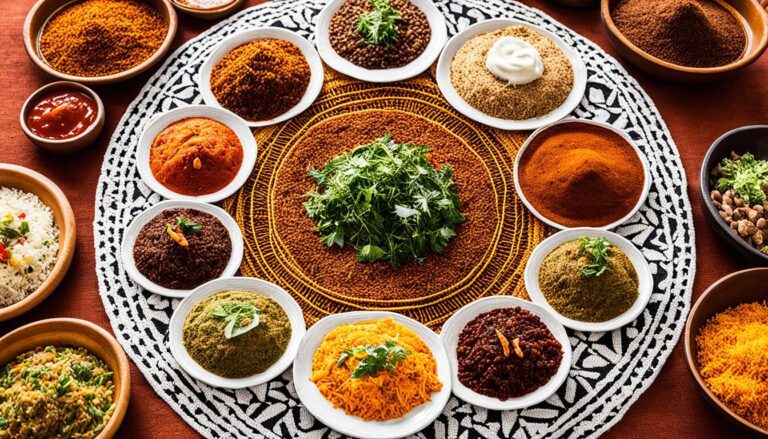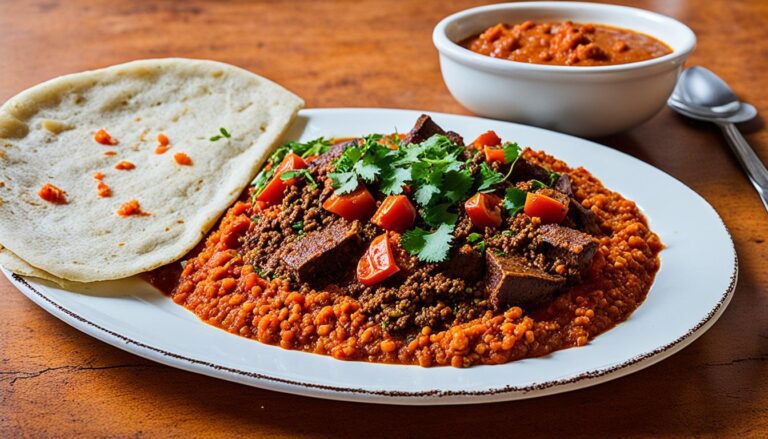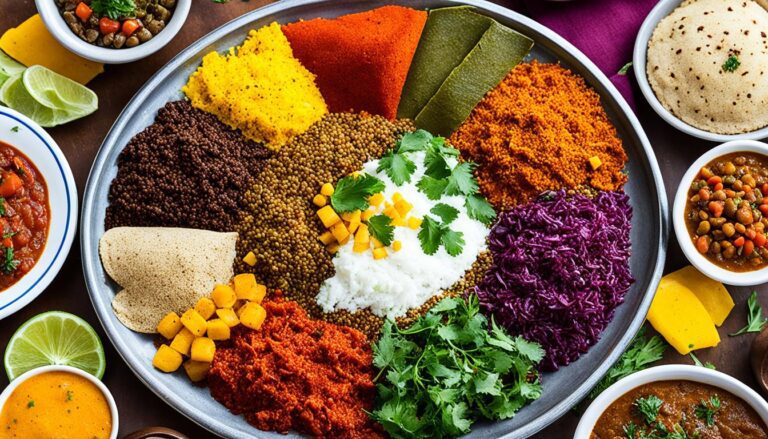Is Ethiopian Food Hard to Make?
Have you ever been intrigued by the vibrant flavors and aromatic spices of Ethiopian cuisine? Perhaps you’ve admired the colorful array of dishes but wondered if it’s too challenging to recreate them in your own kitchen. Today, we’re here to demystify Ethiopian cooking and showcase how you can master the flavorful dishes of this unique cuisine.
From fragrant stews to savory flatbreads, Ethiopian cuisine is known for its bold flavors and diverse range of dishes. But is it really as difficult to make as it may seem? Join us as we explore the essentials of Ethiopian cooking and uncover the secrets to crafting authentic and delicious Ethiopian meals.
Key Takeaways:
- Discover the essence of Ethiopian cuisine, characterized by its vibrant spices and unique flavors.
- Familiarize yourself with the essential ingredients used in Ethiopian cooking, such as the berbere spice blend and teff flour.
- Learn the cooking techniques that contribute to the richness of Ethiopian dishes, including simmering, slow-cooking, and marinating.
- Explore traditional Ethiopian recipes, from the spicy doro wat to the flavorful kitfo, accompanied by the staple injera bread.
- Overcome the challenges of Ethiopian cooking by simplifying recipes and utilizing online resources for guidance.
The Essence of Ethiopian Cuisine
Before we delve into the difficulty level of making Ethiopian food, let’s first understand the essence of this vibrant cuisine.
Ethiopian cuisine is renowned for its unique abundance of spices, which infuse dishes with bold and exotic flavors. These Ethiopian spices play a crucial role in creating the distinctive taste that sets Ethiopian cuisine apart.
One of the quintessential components of Ethiopian meals is injera, a spongy flatbread that serves as both a utensil and a staple in Ethiopian dining. Injera is made from teff flour, an ancient grain, giving it a slightly tangy flavor and a unique texture that perfectly complements the flavors of Ethiopian dishes.
When enjoying an Ethiopian feast, it’s common to see injera spread out on a large platter, topped with various stews and dishes. The injera acts as a delicious edible base, soaking up the flavorful sauces and creating a harmonious blend of tastes.
Now let’s take a closer look at the unique flavors that Ethiopian spices bring to the table and explore the traditional dishes that make Ethiopian cuisine truly special.
Essential Ingredients in Ethiopian Cooking
In order to embark on your Ethiopian culinary journey, it’s important to become familiar with the essential ingredients used in Ethiopian cooking. These ingredients play a crucial role in creating the distinct and vibrant flavors that Ethiopian cuisine is known for.
The Berbere Spice Blend
One of the key ingredients in Ethiopian cooking is the berbere spice blend. Made from a harmonious medley of spices, including chili peppers, paprika, fenugreek, and more, this aromatic spice blend adds both heat and complexity to a variety of Ethiopian dishes. It has a rich, smoky flavor profile that makes it a staple in Ethiopian cuisine, especially in stews like doro wat and misir wat. The berbere spice blend is an essential component for recreating the authentic taste of Ethiopian food.
Teff Flour
Teff flour is another essential ingredient used extensively in Ethiopian cooking. It is a gluten-free ancient grain flour that forms the base of injera, the spongy flatbread that is a staple in Ethiopian meals. Teff flour gives injera its distinctive tangy flavor and unique texture. This nutritious grain is packed with protein, fiber, and various vitamins and minerals, making it a versatile ingredient in Ethiopian cuisine. Teff flour is an integral part of Ethiopian culture and culinary tradition.
Niter Kibbeh
Niter kibbeh is a spiced clarified butter that imparts a rich and aromatic flavor to many Ethiopian dishes. Made by simmering butter with various spices like ginger, garlic, and cardamom, Niter kibbeh adds depth and complexity to stews, sautés, and more. Its unique taste and aroma make it a vital ingredient in Ethiopian cooking, enhancing the overall flavor profile of the dishes. Niter kibbeh is an indispensable element for achieving the authentic taste of Ethiopian cuisine.
To truly experience the diverse flavors of Ethiopian food, it’s essential to include these key ingredients in your pantry. The berbere spice blend, teff flour, and niter kibbeh form the foundation of Ethiopian cooking, allowing you to recreate the vibrant and tantalizing flavors of this remarkable cuisine in your own kitchen.

Mastering Ethiopian Cooking Techniques
When it comes to Ethiopian cuisine, mastering the unique cooking techniques is the key to creating flavorful and authentic dishes. The art of simmering and slow-cooking is fundamental in allowing the flavors of the spices to fully infuse the dishes, resulting in rich and aromatic meals that will transport you to the heart of Ethiopia.
Simmering is a gentle cooking method that involves cooking food in liquid at a low temperature. It is commonly used in Ethiopian cooking to develop deep flavors and tenderize meats. Whether you’re preparing a hearty stew or a savory sauce, simmering allows the ingredients to meld together and create a harmonious blend of tastes.
Slow-cooking, another essential technique in Ethiopian cuisine, involves cooking food over a longer period of time at a low temperature. This method allows the flavors to deepen and intensify, resulting in tender and succulent dishes. Whether you’re slow-cooking a flavorful curry or a comforting lentil dish, the slow and steady process will yield unparalleled taste and texture.
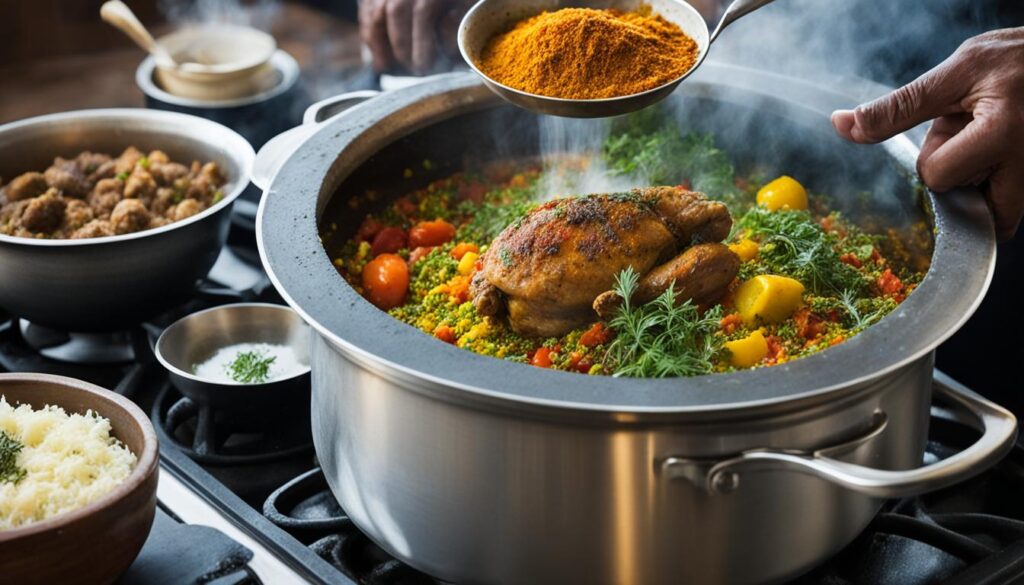
In addition to simmering and slow-cooking, marinating is another popular technique used in Ethiopian cooking. Marinating involves soaking meats or vegetables in a flavorful mixture, allowing them to absorb the flavors and become tender. This technique not only enhances the taste of the ingredients but also helps to break down tough fibers, resulting in more tender and juicy meats.
By understanding and mastering these cooking techniques, you will be able to recreate the vibrant and delicious flavors of Ethiopian cuisine in your own kitchen. Whether you’re simmering fragrant spices, slow-cooking a savory dish, or marinating meat to perfection, these techniques will elevate your Ethiopian cooking to a whole new level.
Exploring Traditional Ethiopian Recipes
Now that we have a grasp of Ethiopian ingredients and cooking techniques, it’s time to explore some traditional Ethiopian recipes. From the flavorful and spicy chicken stew known as doro wat to the minced raw meat dish called kitfo, Ethiopian cuisine offers a range of dishes that cater to various tastes. These recipes often incorporate injera as an accompaniment, providing a delightful combination of flavors and textures.
Flavorful Doro Wat
Doro Wat is a beloved Ethiopian dish that brings together succulent chicken with a rich, spicy sauce. It is traditionally made with chicken legs and thighs, slow-cooked in a flavorful blend of berbere spice and aromatic ingredients. The result is a mouthwatering stew that is bursting with complex flavors. Doro Wat is typically served with injera to soak up the delicious sauce.
Delectable Kitfo
Kitfo is a must-try Ethiopian dish for adventurous meat lovers. This dish features minced raw beef that is spiced and seasoned with traditional Ethiopian spices, including mitmita and niter kibbeh. The meat is typically served warm, accompanied by injera and a side of cheese or vegetables. The combination of flavors in kitfo creates a unique and satisfying culinary experience.
These traditional Ethiopian recipes offer a glimpse into the rich and diverse culinary heritage of Ethiopia. By embracing the bold flavors of doro wat and kitfo, paired with the soft and tangy injera, you can embark on a delicious journey through Ethiopian cuisine.
Overcoming Challenges in Ethiopian Cooking
While the flavors of Ethiopian cuisine are undeniably enticing, aspiring Ethiopian cooks may encounter a few challenges along the way. The preparation of Ethiopian dishes can be time-consuming, requiring patience and dedication. The lengthy cooking and marinating processes ensure that the flavors fully develop and infuse into the dishes, resulting in the rich and complex taste Ethiopian cuisine is known for.
In addition to the time commitment, aspiring cooks may also come across unfamiliar ingredients when preparing Ethiopian dishes. Ethiopian cuisine utilizes unique spices, such as the vibrant and aromatic berbere spice blend, which may not be readily available in local grocery stores. Acquiring these ingredients may require a trip to specialty stores or online retailers specializing in international cuisine.
Furthermore, one of the essential elements of Ethiopian cooking is the process of fermenting injera batter, the spongy flatbread that accompanies many Ethiopian dishes. Fermentation is a key step in achieving the characteristic tanginess and airy texture of injera. However, this process can be challenging for beginners, as it requires proper temperature control and patience to achieve the desired results.
Despite these challenges, it’s important not to feel discouraged. With practice, time management, and resourcefulness in finding ingredients, you can successfully overcome these obstacles and enjoy the rewarding experience of cooking authentic Ethiopian cuisine in the comfort of your own kitchen.
Tips for Success in Making Ethiopian Food
Don’t be discouraged by the potential challenges of making Ethiopian food. We understand that this vibrant cuisine may seem intimidating at first, but there are various ways to simplify the recipes and make the process more approachable.
One great tip is to use pre-made spice blends. These blends, such as berbere or mitmita, can be found in many grocery stores or online. They save you time and effort in measuring and mixing individual spices, ensuring that you achieve the authentic flavors of Ethiopian dishes.
Another option is to make ingredient substitutions. If you can’t easily find teff flour, which is traditionally used to make injera, you can try using a mix of whole wheat flour and all-purpose flour instead. This substitution will still allow you to enjoy the unique experience of eating with injera.
When you’re just starting out, it can also be helpful to explore online resources. There are numerous blogs, cooking videos, and websites dedicated to Ethiopian cuisine. These resources offer step-by-step guidance, simplified recipes, and helpful tips from experienced cooks. By following along with their instructions and visual demonstrations, you’ll gain confidence in your ability to recreate delicious Ethiopian dishes.
Remember, making Ethiopian food should be a fun and enjoyable experience. Don’t be afraid to experiment and adapt the recipes to suit your tastes and ingredients availability. With simplified recipes, ingredient substitutions, and online resources at your fingertips, you’ll be well on your way to impressing your family and friends with your mastery of Ethiopian cuisine.
Conclusion
In conclusion, Ethiopian cuisine may initially seem challenging with its unique spices, cooking techniques, and traditional recipes. However, with a willingness to explore new flavors and a bit of practice, you can confidently embark on a culinary adventure that will delight your taste buds and introduce you to the diverse world of Ethiopian food.
By familiarizing yourself with essential ingredients like the berbere spice blend, teff flour, and niter kibbeh, you’ll be equipped to recreate the bold and exotic flavors of Ethiopian dishes. Mastering the art of simmering, slow-cooking, and marinating will further enhance the authenticity of your preparations.
While there may be challenges, such as the time-consuming nature of Ethiopian cooking and the need to source unfamiliar ingredients, don’t be discouraged. Simplified recipes, ingredient substitutions, and online resources can help you overcome these obstacles, ensuring a successful Ethiopian culinary experience in your own kitchen.
So, take a leap and immerse yourself in the vibrant world of Ethiopian cuisine. With its rich and flavorful dishes, Ethiopian food offers a delightful journey for your taste buds and a window into the culture and culinary traditions of this fascinating country.

